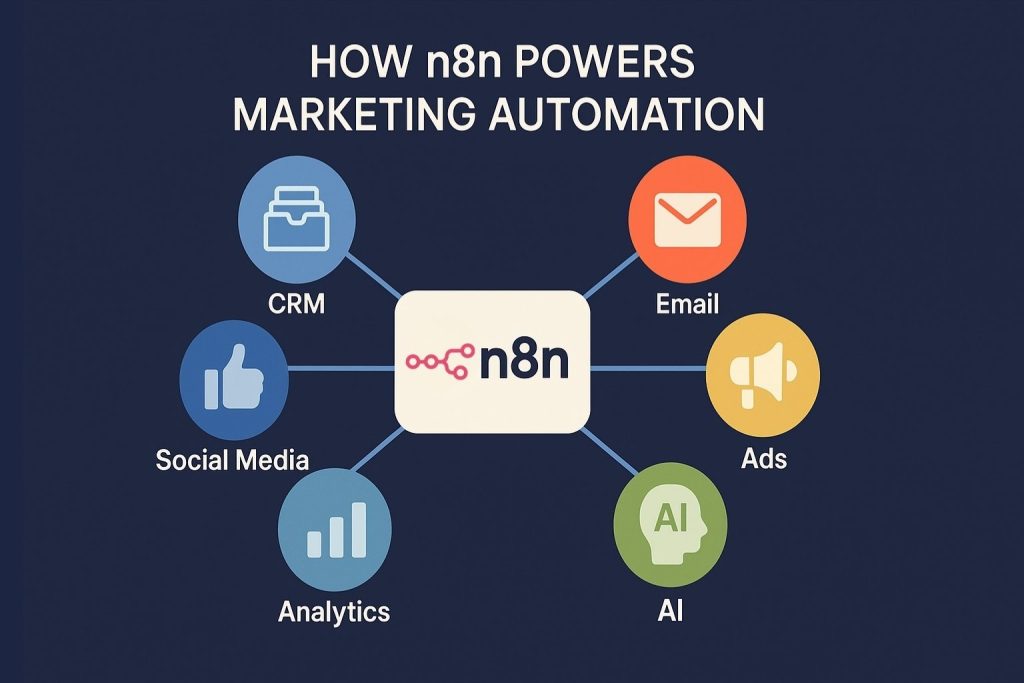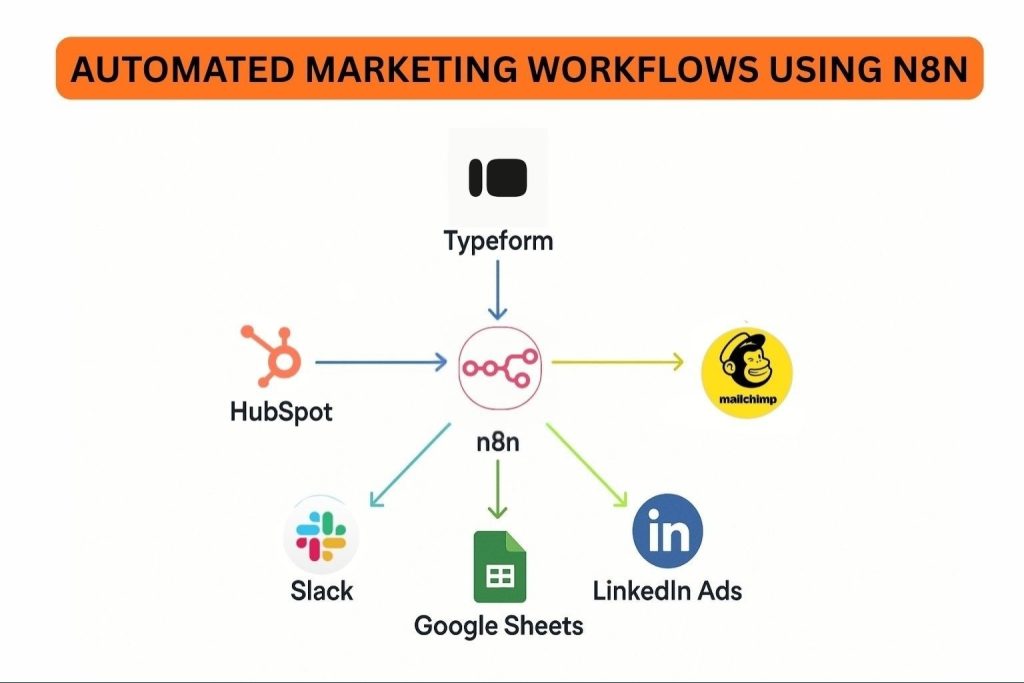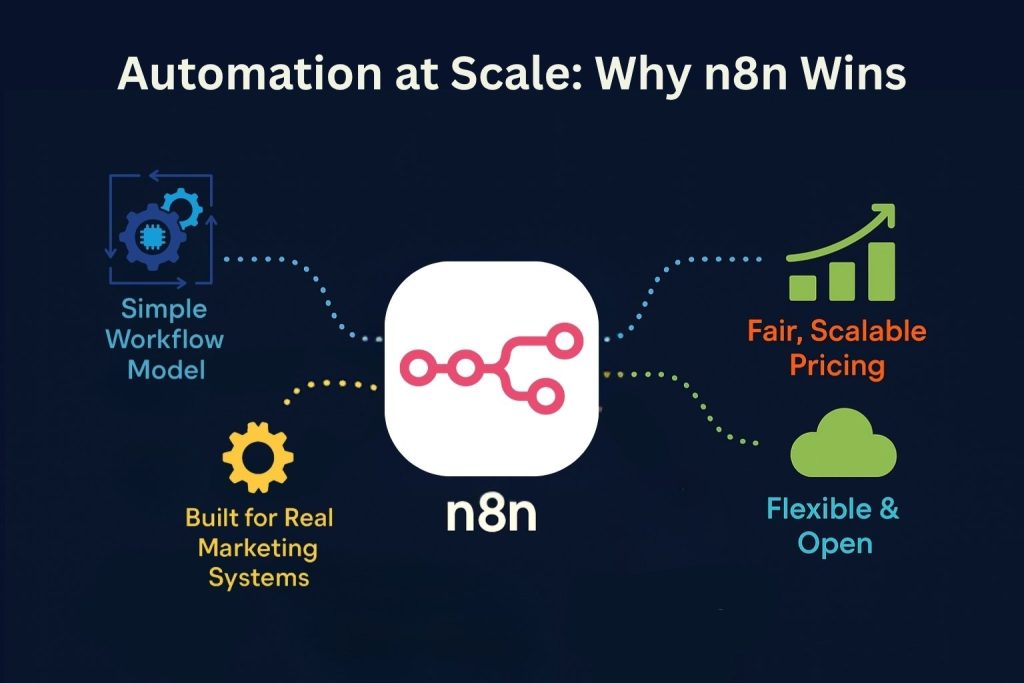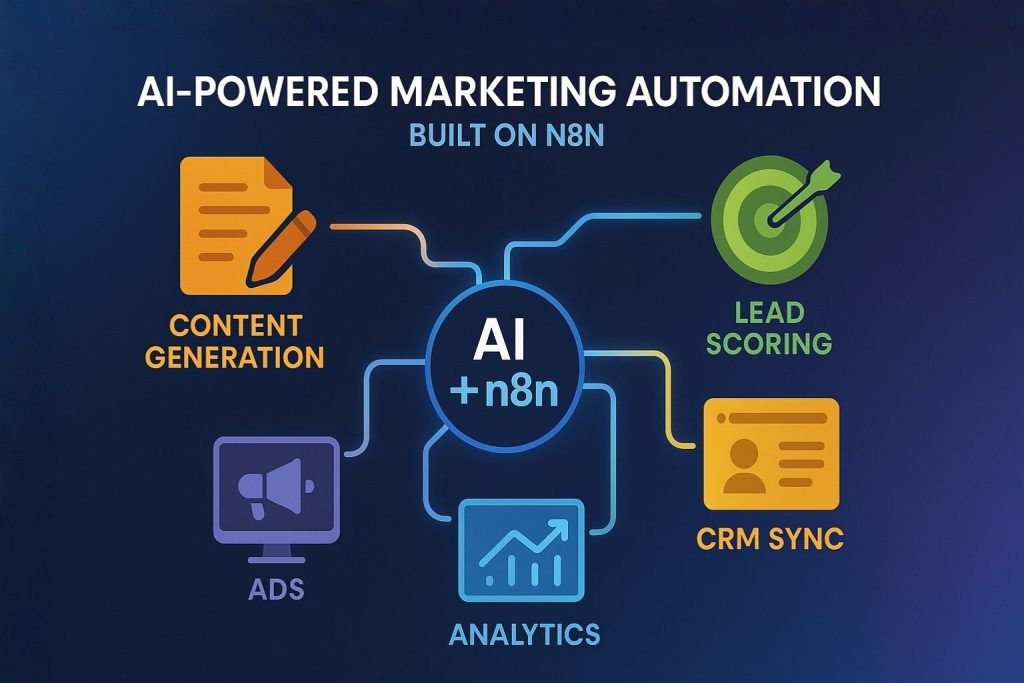- n8n is an open-source, self-hostable automation tool enabling unlimited workflows, flexible integrations, and cost-efficient marketing operations.
- n8n supports advanced marketing automations like CRM syncing, lead scoring, campaign reporting, and AI-assisted content distribution across multiple platforms.
- n8n outperforms Zapier, Make, and HubSpot Workflows through predictable pricing, full API control, and enterprise scalability without vendor lock-in.
I’ve worked with countless automation tools over the years Zapier, Make, HubSpot Workflows, and even custom Python scripts running on cron jobs. They all have their place. But when I need full control, flexibility, and cost-effective scaling for marketing operations, I turn to n8n. This guide is a culmination of everything I’ve learned using n8n for building modern, high-performing marketing engines. If you’re a marketer, marketing ops lead, or agency pro, this is for you.
Let’s get into the meat of it.

What Makes n8n Unique for Marketing Automation
If you’re unfamiliar with n8n (short for “node automation”), here’s the quick version: it’s an open-source workflow automation tool that connects over 1,000 apps and services. It’s designed for low-code users but powerful enough for developers. You can host it yourself or use their cloud offering.
What really sets it apart for marketing teams:
- Unlimited workflows and users
- Pricing based on workflow executions, not individual actions or tasks
- Full customizability with code, HTTP requests, and expressions
- Flexible enough for both startups and enterprise-scale teams
I’ve used it to replace $500/month worth of Zapier automations on a $20 plan and built workflows no other tool could handle due to their API or data limitations.
Common Use Cases in Marketing
n8n isn’t just a tool you install and forget. It’s a system you build to match your marketing funnel. Below are the use cases I’ve either implemented personally or seen work beautifully in client orgs.
1. Lead Nurturing & Email Campaigns
This is where n8n shines. You can build conditional workflows that respond to form submissions, lead scoring, or even product events. For instance, if a lead downloads an eBook and then signs up for a webinar, you can route them into a personalized email sequence using Mailchimp or ActiveCampaign, fully automated.
I typically trigger these flows via webhook or form integrations like Typeform, and the follow-up logic is handled in n8n with ease.
2. CRM Syncing and Data Hygiene
Marketing and sales alignment hinges on data sync. I’ve built n8n workflows that instantly push form data into HubSpot, Pipedrive, or Salesforce and enrich the contact via Clearbit or other APIs. n8n is particularly good at handling fallback logic, say, if Clearbit doesn’t return a job title, you can ping LinkedIn or another source.
You can also keep multiple CRMs in sync, or sync Google Sheets with your CRM, which helps for sales ops or reporting purposes.
3. Campaign Analytics and Reporting
Most marketers hate logging into five dashboards to get a campaign overview. I’ve used n8n to pull performance data from Google Ads, Facebook Ads, and LinkedIn Campaign Manager, then pipe it into Google Sheets or Notion dashboards daily. The workflows can be triggered via cron jobs and include error handling and logging.
There’s also room here for blending campaign data with CRM data to show full-funnel performance.
4. Social Media Scheduling and Automation
While Buffer and Hootsuite are great, n8n lets me build workflows that take new blog posts or content from Notion, generate post variants using GPT-4, and publish them across LinkedIn, Twitter, and Facebook.
Some clients also run automations to schedule promotional posts tied to a product release calendar, pulling the copy from Airtable and tracking posts in a shared spreadsheet.
5. Lead Scoring and Alerting
n8n is fantastic for implementing custom lead scoring. You can use behavioral data like email opens, web visits, and webinar attendance to increment scores, then trigger Slack alerts when a lead crosses a threshold. This replaces expensive marketing automation systems like Marketo or Pardot for many smaller teams.
I’ve even set up lead scoring logic to update CRM fields and trigger internal workflows for sales outreach.
6. Segmentation and Personalization
Personalized marketing without data-driven segmentation is just guesswork. n8n allows you to create dynamic audience segments by checking data in real time, like adding leads to “warm,” “cold,” or “MQL” segments based on campaign interactions.
You can sync these segments with email platforms or ad audiences, making retargeting and drip campaigns more relevant and effective.
7. Event and Webinar Automation
For a recent webinar campaign, we automated the entire workflow: registration via Zoom → contact added to HubSpot → confirmation email sent via SendGrid → reminder emails scheduled → attendance logged → follow-up emails tailored by attendance behavior.
With n8n, I built the whole thing without relying on separate tools talking to each other through clunky integrations.
Workflow Templates Tailored to Marketing
One of the reasons I recommend n8n is the massive template library. You don’t have to start from scratch. Many templates are battle-tested by marketers and ops professionals in the community.
Here are the ones I’ve found most useful:
Lead Capture & Follow-up
- Trigger: New Typeform submission
- Action: Add contact to HubSpot, tag them, send a personalized Gmail message, and log in Google Sheets
- Why it’s great: Removes friction from lead follow-up. Perfect for high-converting landing pages or gated content.
Drip Email Campaigns via Google Sheets
- Trigger: Cron or manual start
- Action: Read rows from a Google Sheet and send staggered, personalized emails via Gmail or Outlook
- Add-on: Include custom fields like industry or company to tailor the messaging
- Best for: Cold outreach, newsletter sequences, post-event follow-ups
LinkedIn Post → Personalized Cold Outreach
- Trigger: New LinkedIn post (or manual paste)
- Action: Extract post summary, use GPT-4 to write a cold email intro, and send to a list from Airtable
- Used by: Agencies and B2B startups doing social selling
Facebook Lead Ads → CRM + Email
- Trigger: New Facebook lead
- Action: Add to HubSpot, assign lead owner, and send intro email
- Plus: Push lead into Slack for immediate sales notification
HubSpot Deals → Custom Google Sheets Dashboard
- Trigger: New or updated deal in HubSpot
- Action: Append to a specific Google Sheet tab, grouped by sales rep or region
- Use case: Live revenue dashboards for marketing + sales sync
AI-Assisted Content Automation
- Trigger: New blog post in Notion
- Action: Use OpenAI to generate social post variations, auto-schedule with Buffer or Twitter API
- Why it works: Pairs AI content generation with scheduled publishing to maintain content cadence
Data Enrichment Workflows
- Trigger: New lead in CRM
- Action: Ping Clearbit, Hunter, or other data services; update CRM with enriched data
- Output: Sales team gets a complete lead profile, fast
Key Integrations and How I Use Them in Real Marketing Workflows
One of the biggest reasons I rely on n8n is the breadth and flexibility of its marketing integrations. Some platforms lock you into their ecosystem. Others only connect on a superficial level, which forces you to duct-tape workflows together. With n8n, I can orchestrate the full marketing stack with clean logic and API‑level control.
Below are the integrations that matter most for marketing teams, along with the exact ways I leverage them in production.

HubSpot CRM
HubSpot sits at the center of many marketing organizations, so I treat it as the source of truth for all contact and company data.
With n8n, I typically automate:
- Contact creation and deduplication
- Lifecycle stage updates
- Lead owner assignments
- Lead scoring field updates
- Deal creation from form submissions or product signals
- Slack or email alerts for high‑intent leads
n8n gives me full read and write access. I can enrich data before it hits HubSpot, validate fields, or trigger conditional routing. This prevents messy CRM data and reduces noise for sales.
Mailchimp and Other Email Platforms (ActiveCampaign, MailerLite, Brevo)
Email platforms are usually downstream from the CRM, so I use n8n to make sure the subscriber lists are always clean and segmented.
Common workflows I deploy:
- Auto‑segmenting audiences based on behavior or CRM properties
- Adding or removing contacts from lists in real time
- Triggering targeted broadcasts after a specific event (like a webinar sign‑up)
- Updating tags when a lead hits a scoring threshold
Since n8n supports any email provider with an API, I’m not forced to switch platforms just to automate properly.
Google Ads and Meta (Facebook/Instagram) Ads
Ad platforms can be painful to work with, especially when attribution and reporting require data from both marketing and CRM sources. n8n becomes my reconciliation layer.
I use it to:
- Pull ad performance and load it into Google Sheets or BigQuery
- Sync CRM audience segments to custom audiences
- Trigger retargeting audience updates
- Generate automated ad performance summaries for the team
Cron triggers and errors‑handling nodes make these reporting flows reliable and hands‑off.
For B2B marketing, LinkedIn often plays a major role. I use the LinkedIn nodes to:
- Publish scheduled posts from a content calendar
- Sync engagement data into dashboards
- Handle LinkedIn Lead Gen form submissions and push them into HubSpot with enrichment and auto‑routing
When clients run paid LinkedIn campaigns, I extend these flows to include audience updates and campaign reporting.
Google Analytics and Other Analytics Tools
I don’t want to log into Google Analytics every morning to answer the same question. So I don’t.
Instead, I use n8n to:
- Pull key analytics data on a schedule
- Blend it with CRM or ad spend data
- Send actionable summaries to Slack, Notion, or Google Sheets
This gives me a lightweight, customized reporting layer without buying another SaaS dashboard.
WordPress, Webflow, and CMS Integrations
For content marketing workflows, I automate things like:
- Auto‑publishing or scheduling posts based on editorial calendars
- Triggering distribution after new content goes live
- Running content update checks and notifying stakeholders
This helps teams scale consistent output without the bottleneck of manual publishing and promotion.
Real Case Study from the Field
Dropsolid wanted personalized marketing campaigns, a unified data layer, and a self‑hostable solution that aligned with their open‑source philosophy. They originally tested Zapier, but they hit limits fast and watched costs climb.
I’m not surprised by their move. Using n8n, they were able to:
- Sync CRM and marketing automation data
- Centralize campaign reporting inside Google Sheets and Data Studio
- Automate personalization triggers without buying another marketing platform
- Empower non‑technical team members to build their own workflows
- Cut automation costs dramatically
This is the pattern I see repeatedly with scaling marketing teams: the more complex the workflow, the more n8n pulls ahead of SaaS‑only automation tools.
How I Think About Pricing and Cost Strategy With n8n
Let’s be real. A major driver behind moving to n8n is the cost advantage. Most marketing teams start with tools like Zapier or Make because they’re easy and familiar. But once you scale past a few thousand actions or operations a month, your automation bill becomes a liability.
I’ve migrated teams spending $300–$800/month on Zapier to $50/month on n8n Cloud, or zero if they self-hosted.
Let me break down how that works.

Understanding n8n’s Pricing Model
n8n charges based on workflow executions, not per task or operation. That’s a critical distinction. A single workflow in n8n can run dozens of steps API calls, conditionals, data transformations but it still counts as just one execution.
This makes a huge difference for marketers who need multi-step flows (and we always do).
Here’s how I think about the plans:
- Starter (2,500 executions/month, ~€20/month): Good for a small team testing things out. You can run basic lead capture and reporting workflows.
- Pro (10,000 executions/month, ~€50/month): This is the sweet spot for most marketing teams. It’s enough for daily operations, campaigns, and regular reporting.
- Business (40,000+ executions, €667/month): More for agencies or companies running automations at scale, with dedicated environments, audit logs, SSO, etc.
- Self-hosted (Community Edition = free): If you have DevOps support or a cloud server, this is the most flexible and cost-effective route. You own your infrastructure and your data.
And importantly, every plan includes unlimited users and all integrations. No “premium” nodes, no per-seat pricing.
Zapier, Make, and HubSpot Workflows: The Honest Comparison
I don’t hate Zapier or Make. I’ve used both. But I know when they’re no longer the right tool. Here’s how I explain the tradeoffs to clients:
Zapier
Pros:
- Easy to start with
- Huge integration library
- Tons of prebuilt Zaps
Cons:
- Pricing skyrockets with volume
- Limited logic (especially without Pro plan)
- Complex Zaps become hard to manage
- No self-hosting or data control
Zapier works great for startups or non-technical teams needing quick wins. But it’s not built for complex marketing workflows or scale. When you’re syncing 5 platforms and need custom logic, it gets messy and expensive.
Make (formerly Integromat)
Pros:
- Very visual builder
- Powerful logic and operations
- Cheaper than Zapier
Cons:
- Operation-based pricing adds up
- Workflow management can get cluttered
- No self-hosting option
- Occasional reliability issues with large scenarios
Make is great for visual thinkers. I sometimes prototype ideas there. But like Zapier, its pricing model punishes you for doing anything meaningful at scale.
HubSpot Workflows
Pros:
- Tight CRM integration
- Very intuitive
- Great for internal HubSpot automations
Cons:
- Locked into HubSpot ecosystem
- Poor at external integrations
- Limited logic compared to n8n or code
HubSpot Workflows are excellent if you live entirely inside HubSpot. But the moment you want to orchestrate external platforms (e.g. a webinar tool, analytics API, AI content system), you hit walls.
Where n8n Wins in Practice
Here’s why I choose n8n when performance matters:
- Pricing is predictable and fair. One execution = one cost. It’s honest.
- No seat-based limitations. My whole team can build and test automations without gating access.
- Flexibility to do anything. Custom APIs, complex logic, JavaScript transformations? No problem.
- Self-hosting is possible. For clients in regulated industries or the EU, this is non-negotiable.
- No platform bias. I can connect Mailchimp, HubSpot, Webflow, Zoom, and Notion in one flow.
If you’re building a real marketing engine not just tinkering n8n is the platform that respects your ambition.
How I Onboard Marketers to n8n
If you’re worried that n8n might be too technical, don’t be. I’ve onboarded dozens of marketers with no dev background, and here’s what works:
1. Start With Visual Templates
I always begin with templates, especially those for lead capture, email sequences, and reporting. Seeing a flow visually is far more instructive than reading docs.
I recommend importing a template, walking through the nodes, and tweaking one field at a time.
2. Use the Docs + Forum for Quick Wins
The n8n docs are excellent. The community forum is even better. Almost every problem I’ve hit has been solved there already. Just search for your tool + error, and someone’s walked that path.
3. Gradually Add Complexity
Start with basic flows:
- Typeform → Google Sheet
- HubSpot → Slack
- Facebook Lead → Email
Then layer on logic:
- Conditional branches
- Data transformation
- External API calls
- Error handling
Over time, marketers get comfortable with building their own workflows or working with an ops engineer to build high-performance systems.
4. Use AI + Community Repos
There are entire GitHub repos with curated n8n workflows for marketers. Some even use ChatGPT to write expressions and generate workflow code.
One of my favorites is the N8N Marketing Lab, which bundles 30+ marketing-ready templates with explainer videos.

Final Thoughts: My Personal Stack and Strategy
n8n is the most valuable tool in my marketing ops stack. I treat it like a central nervous system that routes signals between platforms, cleans data, and triggers action.
Here’s a typical stack I run with n8n at the center:
- HubSpot: CRM and lifecycle tracking
- Mailchimp or ActiveCampaign: Email automation
- Airtable: Content calendars and campaign management
- Typeform: Form capture
- Google Sheets: Lightweight reporting
- OpenAI: Personalized content generation
- Slack: Internal notifications
- Zapier: For the odd edge case that’s easier to prototype elsewhere
- n8n: Orchestrating all of it
With this setup, I can build workflows that respond to real behavior, reduce human error, and scale campaigns without ballooning software costs.
Should You Use n8n for Marketing? My Verdict
If you’re serious about marketing automation, especially if you’re running campaigns across multiple tools, want full control, or are trying to reduce spend, n8n is the best-kept secret in the business.
For marketing teams who want:
- To get out from under bloated Zapier bills
- A workflow builder that respects complexity
- Full access to APIs and custom logic
- A future-proof tool that scales with them
I can’t recommend n8n enough.
It’s not just a tool. It’s a strategy.
About RiseOpp and How We Leverage Tools Like n8n
At RiseOpp, we don’t just advise clients on marketing strategy; we build and implement full-stack marketing engines that perform. Whether we’re managing global SEO campaigns using our proprietary Heavy SEO methodology or executing cross-channel campaigns as a Fractional CMO, automation is always part of the equation.
We actively use tools like n8n to orchestrate and scale complex marketing workflows for our clients across industries. From syncing CRM and ad data to creating custom lead scoring systems and automating campaign reporting, n8n helps us deliver smarter, faster, and more cost-effective solutions without locking our clients into expensive MarTech silos.
If you’re looking for a partner who understands the strategic side of marketing and also knows how to build the systems that drive it, we should talk. Whether you’re a B2B brand ready to scale or a consumer-focused company looking for smarter attribution, RiseOpp’s combination of strategic leadership and technical execution is built for the AI age.
Let’s build something that works while you sleep. Contact us today.
Comments are closed